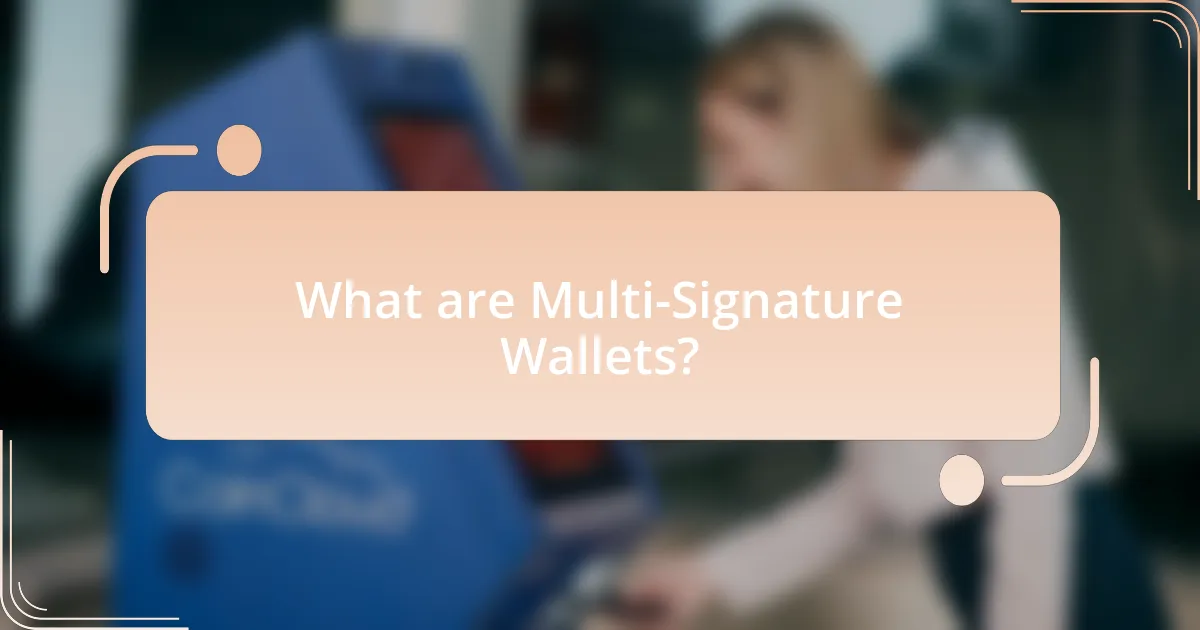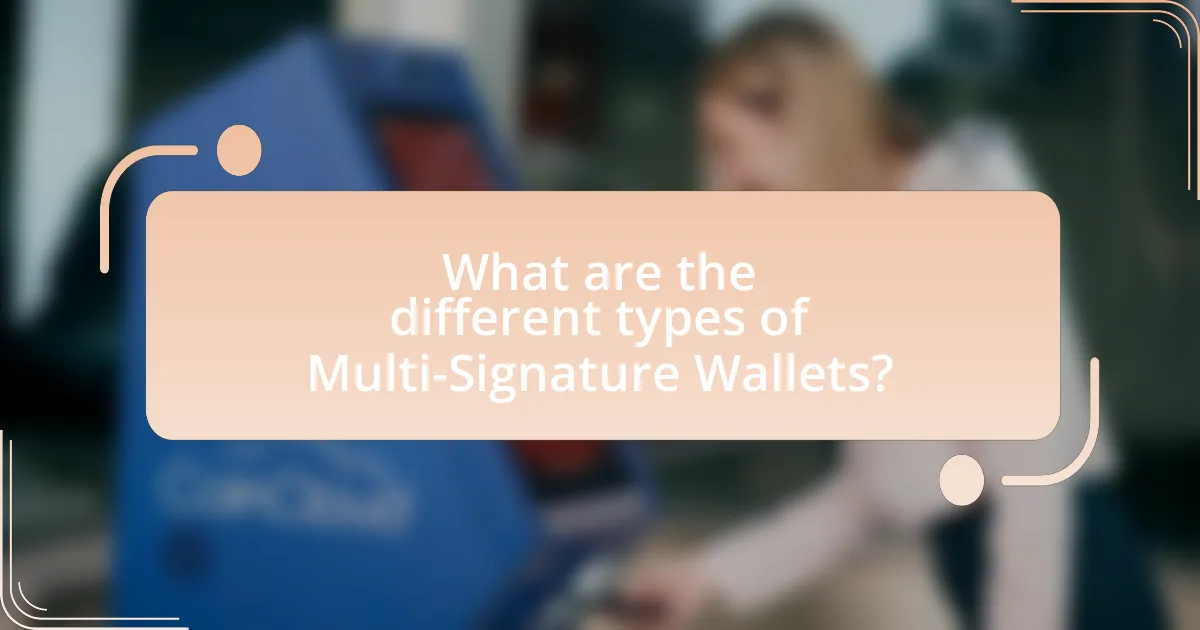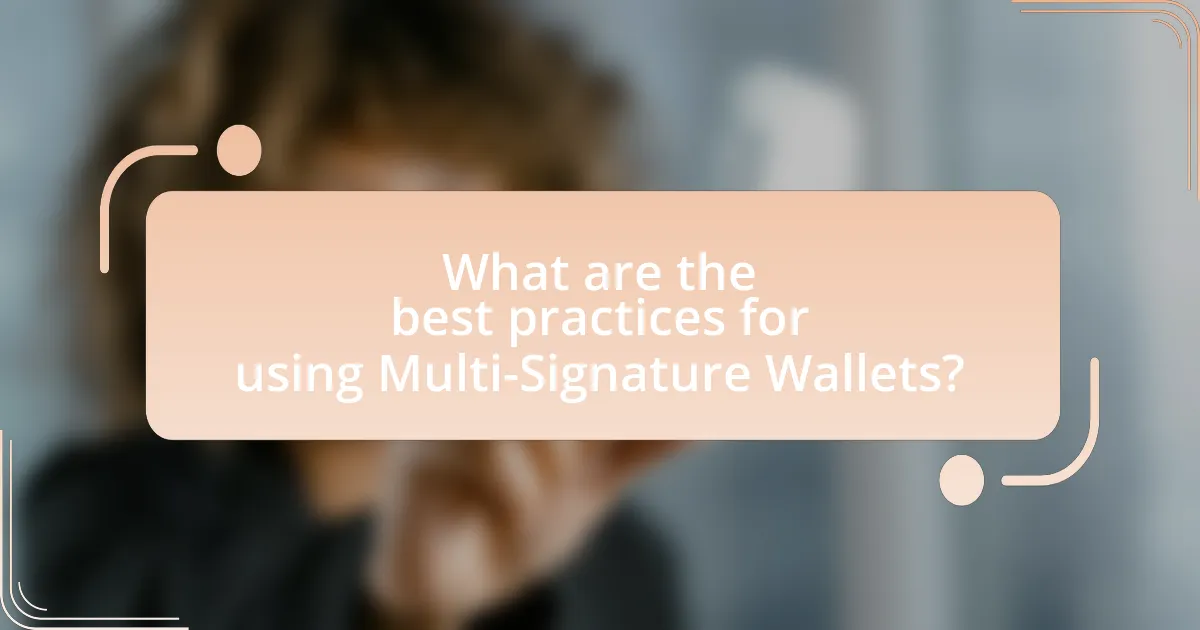Multi-signature wallets are digital wallets that enhance security by requiring multiple private keys to authorize transactions, thereby preventing any single individual from having complete control over the funds. This article explores the functionality of multi-signature wallets, including their key components, the different configurations available, and their importance in mitigating risks such as unauthorized access and fraud. It also discusses best practices for using these wallets, common challenges users face, and how to troubleshoot issues effectively. Additionally, the article highlights various platforms and exchanges that support multi-signature wallets, providing a comprehensive overview of their application in securing digital assets.

What are Multi-Signature Wallets?
Multi-signature wallets are digital wallets that require multiple private keys to authorize a transaction. This feature enhances security by ensuring that no single individual has complete control over the funds, as multiple signatures from different parties are needed to execute any transaction. For example, a multi-signature wallet can be configured to require signatures from three out of five designated users, making unauthorized access significantly more difficult. This structure is particularly useful for organizations and partnerships, where shared control over assets is necessary to prevent fraud and mismanagement.
How do Multi-Signature Wallets function?
Multi-signature wallets function by requiring multiple private keys to authorize a transaction, enhancing security. In these wallets, a predefined number of signatures from different keys is necessary to complete a transaction, which mitigates the risk of unauthorized access. For example, a wallet might be set up to require three out of five possible signatures, meaning that even if one key is compromised, the funds remain secure. This mechanism is particularly useful for organizations or groups, as it ensures that no single individual has complete control over the funds, thereby reducing the likelihood of fraud or theft.
What are the key components of a Multi-Signature Wallet?
A Multi-Signature Wallet consists of several key components: multiple private keys, a defined threshold for signatures, and a transaction verification process. Multiple private keys are essential as they require more than one keyholder to authorize a transaction, enhancing security. The defined threshold specifies how many signatures are needed to approve a transaction, which can vary based on the wallet’s configuration, such as requiring 2 out of 3 keys. The transaction verification process ensures that all required signatures are collected and validated before a transaction is executed, preventing unauthorized access and enhancing the overall security of the wallet.
How do signatures work in a Multi-Signature Wallet?
In a Multi-Signature Wallet, signatures function by requiring multiple private keys to authorize a transaction, enhancing security. Each participant in the wallet holds a unique private key, and a predefined number of these keys must sign a transaction for it to be executed. For example, in a 2-of-3 multi-signature setup, at least two out of three key holders must provide their signatures to approve a transaction. This mechanism prevents unauthorized access, as a single compromised key is insufficient to execute transactions, thereby significantly reducing the risk of theft or fraud.
Why are Multi-Signature Wallets important for security?
Multi-signature wallets are important for security because they require multiple private keys to authorize a transaction, significantly reducing the risk of unauthorized access. This multi-key requirement ensures that even if one key is compromised, the funds remain secure as additional approvals are necessary for any transaction. For instance, in a corporate setting, a multi-signature wallet can be configured to require signatures from several executives before funds can be moved, thereby preventing any single individual from having unilateral control over the assets. This layered approach to security is particularly effective against hacking attempts and internal fraud, as it adds complexity to the process of accessing funds.
What risks do Multi-Signature Wallets mitigate?
Multi-signature wallets mitigate several risks associated with cryptocurrency management, primarily unauthorized access and single point of failure. By requiring multiple private keys to authorize a transaction, these wallets significantly reduce the likelihood of theft, as a single compromised key is insufficient for access. Additionally, they protect against loss of funds due to the failure of one individual, as multiple signatures are needed for transaction approval. This distributed control mechanism enhances security, making it more difficult for malicious actors to execute unauthorized transactions.
How do Multi-Signature Wallets enhance user control?
Multi-signature wallets enhance user control by requiring multiple private keys to authorize a transaction, thereby distributing control among several parties. This mechanism prevents any single individual from having complete authority over the funds, reducing the risk of theft or unauthorized access. For instance, in a multi-signature setup requiring three out of five signatures, even if one key is compromised, the funds remain secure as the attacker cannot execute transactions without the additional keys. This structure not only increases security but also fosters collaborative decision-making among users, as they must agree before any transaction can occur.

What are the different types of Multi-Signature Wallets?
There are several types of multi-signature wallets, primarily categorized by the number of signatures required for transactions. The most common types include 2-of-2 wallets, which require both parties to sign a transaction; 2-of-3 wallets, which require two out of three possible signatures; and n-of-m wallets, where ‘n’ signatures are needed from ‘m’ total signers. These configurations enhance security by distributing control among multiple parties, reducing the risk of unauthorized access. For example, a 2-of-3 wallet can be used in a business setting where three executives must approve a transaction, ensuring that no single individual has unilateral control over the funds.
How do different configurations of Multi-Signature Wallets work?
Different configurations of Multi-Signature Wallets work by requiring multiple private keys to authorize a transaction, enhancing security. For example, a 2-of-3 configuration necessitates that two out of three designated signers approve a transaction before it is executed. This setup mitigates risks associated with single points of failure, as no single keyholder can unilaterally access the funds. Additionally, configurations can vary, such as 3-of-5 or 1-of-2, allowing for flexibility in security and accessibility based on the needs of the users. The effectiveness of these configurations is evidenced by their use in securing significant cryptocurrency holdings and facilitating collaborative management of assets, thereby demonstrating their practical application in real-world scenarios.
What is the difference between 2-of-3 and 3-of-5 Multi-Signature Wallets?
The difference between 2-of-3 and 3-of-5 multi-signature wallets lies in the number of signatures required to authorize a transaction. In a 2-of-3 wallet, two out of three designated signers must approve a transaction for it to be executed, providing a balance of security and accessibility. Conversely, a 3-of-5 wallet requires three out of five designated signers to authorize a transaction, which enhances security but may reduce accessibility due to the higher number of required approvals. This structure allows for varying levels of security and flexibility based on the number of participants involved in the wallet management.
What are the use cases for various Multi-Signature Wallet configurations?
Multi-signature wallets have several use cases that enhance security and facilitate collaborative management of digital assets. One prominent use case is for businesses, where multiple stakeholders can be required to authorize transactions, reducing the risk of fraud or mismanagement. Another use case is for families or groups, allowing shared control over funds, ensuring that no single individual can unilaterally access or spend the assets. Additionally, multi-signature wallets are utilized in escrow services, where funds are held until predefined conditions are met, requiring signatures from multiple parties to release the funds. These configurations provide a robust security framework, as they mitigate the risk of loss due to a single point of failure, such as a compromised private key.
What platforms support Multi-Signature Wallets?
Several platforms support Multi-Signature Wallets, including Bitcoin, Ethereum, and various cryptocurrency exchanges such as Coinbase, Binance, and Kraken. These platforms implement multi-signature technology to enhance security by requiring multiple private keys to authorize transactions, thereby reducing the risk of unauthorized access. For instance, Bitcoin’s protocol allows for the creation of multi-signature addresses, which can be configured to require signatures from multiple parties before a transaction can be executed.
Which cryptocurrency exchanges offer Multi-Signature Wallets?
Several cryptocurrency exchanges offer Multi-Signature Wallets, including Coinbase, Binance, Kraken, and Bitfinex. These exchanges implement multi-signature technology to enhance security by requiring multiple private keys to authorize transactions, thereby reducing the risk of unauthorized access. For instance, Coinbase provides a multi-signature feature for its institutional clients, ensuring that funds are safeguarded through a collaborative approval process.
How do wallets like Electrum and BitGo implement Multi-Signature features?
Electrum and BitGo implement Multi-Signature features by requiring multiple private keys to authorize a transaction, enhancing security. Electrum allows users to create wallets that require signatures from multiple devices or users, enabling configurations such as 2-of-3 or 3-of-5 signatures, which means that a specified number of keys must sign a transaction before it is executed. BitGo, on the other hand, offers a similar approach but focuses on enterprise solutions, allowing organizations to set up wallets that require multiple approvals for transactions, thus preventing unauthorized access. Both wallets utilize cryptographic techniques to ensure that private keys are securely stored and managed, making it difficult for a single point of failure to compromise the funds.

What are the best practices for using Multi-Signature Wallets?
The best practices for using Multi-Signature Wallets include selecting a secure and reputable wallet provider, defining the appropriate number of signatures required for transactions, and distributing private keys among trusted individuals or secure locations. A secure wallet provider ensures that the wallet’s infrastructure is robust against attacks, while the right number of signatures balances security and accessibility; for example, a common configuration is 2-of-3, where two signatures are needed from three total keys. Distributing private keys mitigates the risk of loss or theft, as no single point of failure exists. Following these practices enhances the security of assets held in multi-signature wallets, as evidenced by the increased adoption of this technology in high-value transactions and institutional use cases.
How can users ensure the security of their Multi-Signature Wallets?
Users can ensure the security of their Multi-Signature Wallets by implementing strong access controls and regularly updating their security practices. This includes using complex, unique passwords for each signer, enabling two-factor authentication, and ensuring that private keys are stored securely, preferably in hardware wallets or secure offline environments. Additionally, users should regularly review and update the list of signers to ensure that only trusted individuals have access. According to a report by the Blockchain Security Alliance, multi-signature wallets significantly reduce the risk of unauthorized access, as they require multiple approvals for transactions, thereby enhancing overall security.
What steps should be taken to manage keys securely?
To manage keys securely, implement a multi-signature wallet system that requires multiple private keys for transaction approval. This approach enhances security by distributing control among several parties, reducing the risk of a single point of failure. For instance, a 2-of-3 multi-signature wallet requires two out of three keys to authorize a transaction, making unauthorized access significantly more difficult. Additionally, regularly update and rotate keys, use hardware wallets for storage, and ensure that backup copies are securely stored in separate locations to prevent loss or theft.
How can users recover access to their Multi-Signature Wallets?
Users can recover access to their Multi-Signature Wallets by utilizing the recovery keys or seed phrases associated with the wallet. Each Multi-Signature Wallet typically requires multiple private keys for transactions, and if a user loses access to their wallet, they can regain access by using the remaining keys or the recovery phrase that was generated during the wallet setup. This process is supported by the fact that Multi-Signature Wallets are designed to enhance security by distributing control among multiple parties, ensuring that access can be restored as long as the necessary keys or phrases are available.
What common challenges do users face with Multi-Signature Wallets?
Users face several common challenges with Multi-Signature Wallets, including complexity in setup, potential for lost access, and coordination issues among multiple signers. The complexity arises from the need to configure multiple keys and permissions, which can be confusing for less technical users. Additionally, if one signer loses their key or access, it can hinder the ability to authorize transactions, potentially locking out all users. Coordination issues can occur when multiple parties must agree on transactions, leading to delays and inefficiencies. These challenges highlight the importance of user education and clear protocols in managing Multi-Signature Wallets effectively.
What are the potential pitfalls of using Multi-Signature Wallets?
The potential pitfalls of using Multi-Signature Wallets include complexity in management, risk of loss of access, and potential for disputes among signers. The complexity arises from the need to coordinate multiple private keys, which can lead to user errors or mismanagement. If one key is lost or inaccessible, it can result in the inability to access the funds, especially if the wallet requires all keys for transactions. Additionally, disagreements among signers regarding transaction approvals can create delays or prevent access to funds altogether. These issues highlight the importance of careful planning and management when utilizing Multi-Signature Wallets.
How can users troubleshoot issues with Multi-Signature Wallets?
Users can troubleshoot issues with Multi-Signature Wallets by verifying the signatures required for transactions and ensuring that all co-signers have access to their private keys. If a transaction fails, users should check the wallet’s settings to confirm that the correct number of signatures is configured and that all involved parties are online and able to sign. Additionally, users can consult the wallet’s documentation or support resources for specific error messages or issues. This approach is effective because many common problems stem from misconfigured settings or lack of access to necessary keys, which can be resolved through careful verification and communication among co-signers.
What tips can enhance the user experience with Multi-Signature Wallets?
To enhance the user experience with Multi-Signature Wallets, users should prioritize clear communication among signers, utilize intuitive interfaces, and ensure robust security practices. Clear communication among all parties involved in the multi-signature process minimizes misunderstandings and facilitates smoother transactions. Intuitive interfaces simplify the user experience, making it easier for individuals to navigate the wallet’s features without confusion. Additionally, implementing robust security practices, such as regular updates and strong password management, protects against unauthorized access and enhances overall trust in the wallet’s functionality. These strategies collectively improve usability and security, making multi-signature wallets more effective for users.